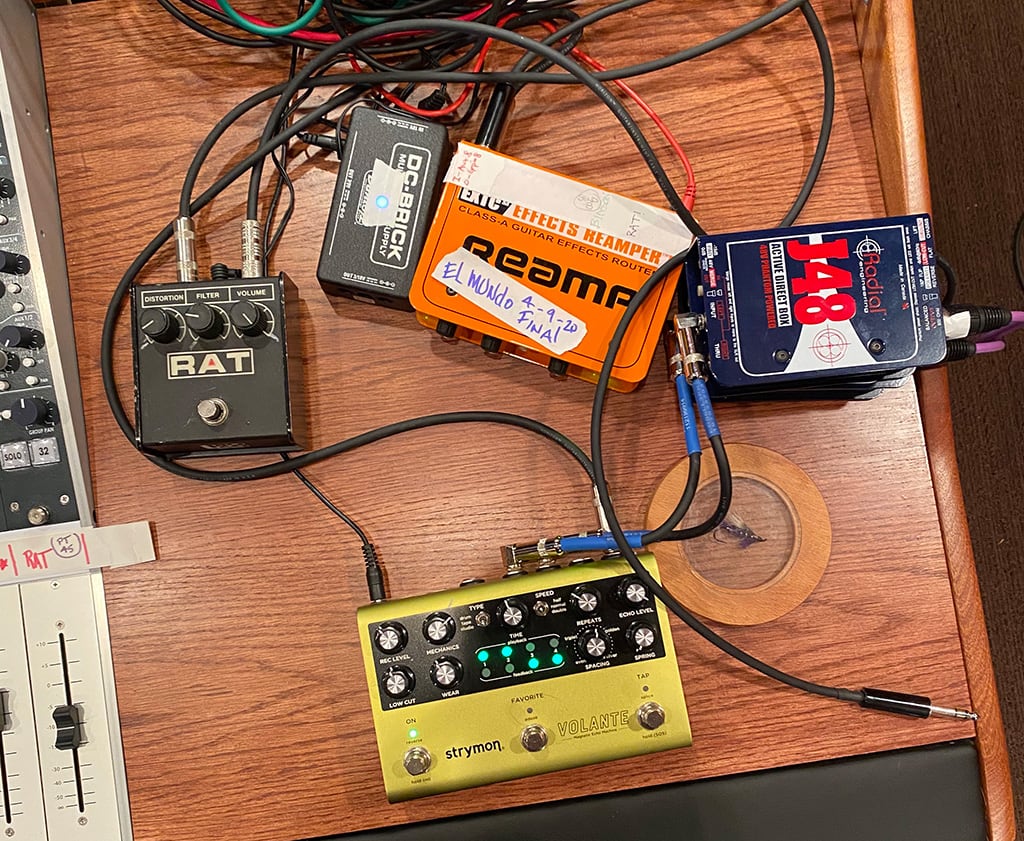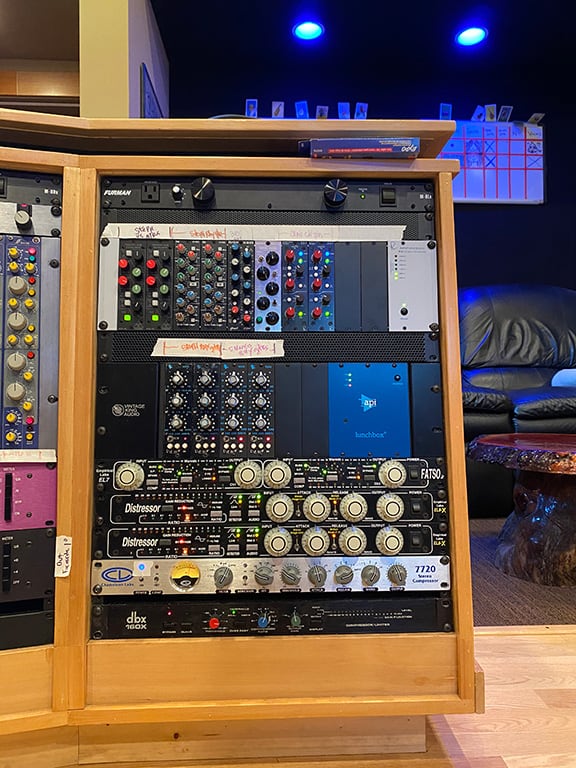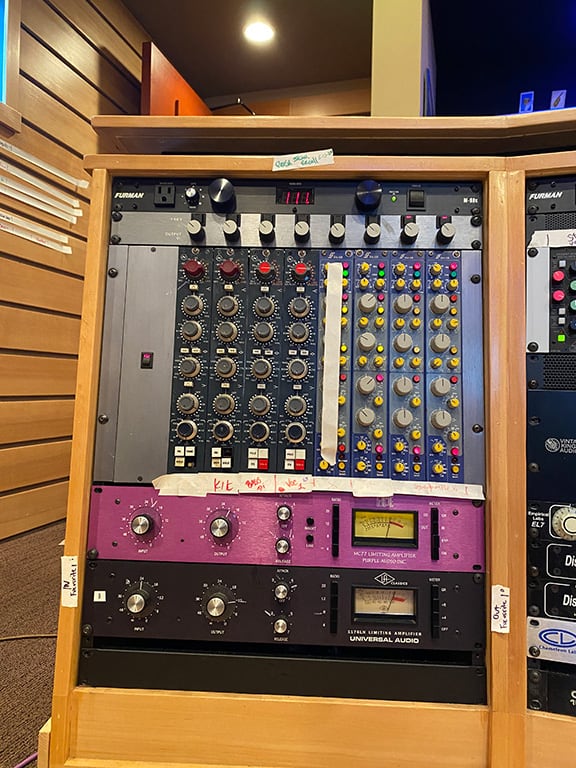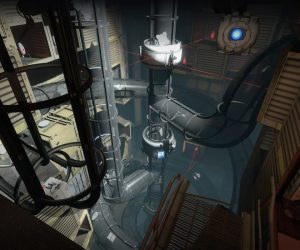
Deft Touch
Veteran record engineer and producer, Terry Date, lifts the lid on the making of Deftones’ latest, Ohms, and how he helped create the Seattle sound.

Album: Ohms
Artist: Deftones
“I’m pretty old school,” asserts Terry Date. In different variations, he states this at least a dozen times over the course of our two-hour interview. He also repeatedly laments his limited computer skills, expressing his awe at multi-tasking young people who are able to handle computers, and phones, while doing something entirely different at the same time. In short, at the age of 64, Date sounds like he feels he’s being overtaken by the 21st century. The fact that his home studio near Seattle, called Trainwreck, is stacked with old-school analogue gear adds to this impression.
All this is peculiar, because the records Date makes sound as current as anything out there today. The most recent case in point is Deftones’ ninth studio album, Ohms. It’s big, brash, and beautiful, with big bass, brutal guitars, and in-your-face everything-else. The album has been met with universal acclaim, with one critic claiming the band “haven’t sounded this refreshed in years”. It also reached No.3 in Australia, and No.5 on the Billboard 200 chart. Nothing ‘old school’ about all this.
With a swag of top-draw credits (Pantera, Soundgarden, Slayer, Slipknot et al), Date is legendary for being one of the main architects of the metal sound that emerged in the ’80s and ’90s. Productions of hard rock, the genre on which metal was built, tended to have a lot of space, contrary to the wall-of-sound, in-your-face, hyper-aggression of metal productions. Ironically, Date isn’t actually a metal freak, but became one of the master producers of the genre through circumstances.
“Earlier on in my career, in the mid ’80s, I worked with a band called Metal Church, and I then did their second and third albums, and started getting calls from other metals bands on the East Coast. That was what kickstarted my career.
“I really was not familiar with metal at that time. I knew The Ramones and Black Sabbath, and those were my references. I got a lot of calls from hair metal bands, and then the grunge thing hit in Seattle, and as I was the local guy here, Soundgarden came to me, and I did their first major label record. It was a different kind of metal. After I started working with Pantera (Cowboys from Hell, 1990; Vulgar Display of Power, 1992), I tried to diversify as much as I could, for example working with Fishbone, but I almost always ended up working with metal bands!”

I immediately go in there sonically, to make sure it sounds great and inspiring as early as possible. I want them to feel pumped up by the sound
DATE WITH DESTINY
Given that Date has worked on several genre-defining metal albums, and has managed to make a career out of it, he’s not complaining. But when he started out in the mid ’70s, hard rock or metal were far from his mind. Born in Michigan, Date worked at a small college radio station, where he “became fascinated with the documentation process of recording. I moved to Seattle, and worked in clubs for a bit, and then started working at a studio called Steve Lawson Productions, which became Bad Animals Studios. It became synonymous with the grunge movement—all the bands worked there.”
A guitarist and producer called Paul Speer became Date’s mentor, but beyond that, he says, “I did not learn from anyone else.” Date went freelance in 1986, and developed the metal sound as he went, based on a few influences. “When I was in high school I was a big fan of the early Rush records, which were doing the double guitar thing, with one guitar coming from each speaker, pretty extensively. It creates that wall of sound. So even if there was only one guitarist in the band, like with Pantera, I will always double, left and right. Automatically. The other thing is that when you have these heavy, disported guitars coming at you from both speakers, they take a lot of space. You have the fit the bass in there, and the vocals. For me it was, and still is, an exercise in carving holes in the sound, using EQ.”
Beyond this, stresses Date, there’s no formula when he produces metal records. “I have always tried not to have a formula, because every band is unique. Pantera, for example, did not want compression on anything. They hated compression, so I did all their records without it. Other bands would want more compression, because it makes things more aggressive and puts them right in your face.
“I always try to let the band’s identity come through. Personally, I feel my job is more that of a photographer. I don’t start making a record with a final product in my head. I just go along for the ride, and then I see where it ends up. My goals when I produce are to make the band believe they are better than they think they are, and sonically to make things as inspiring as possible. I’m old school. I like for the whole band to lay down basic tracks together, to create the vibe for the record, and I immediately go in there sonically, to make sure it sounds great and inspiring as early as possible. I want them to feel pumped up by the sound, and this will inspire them when they do overdubs.”


OHM’S LAW
After having made their first four albums with Date, Deftones made another four with the likes of Bob Ezrin, Nick Raskulinecz, and Matt Hyde. It was big news when Deftones started to work again with their original producer for Ohms. “I have no idea why they came back to me,” says Date, “but we have been friends from day one, and I actually encouraged them to work with other people, so they could see other things. I think it really helped them as a band. When they came back, it was like making a record with your family. It was very comfortable.”
Ohms was very much made according to the approach Date described above, with basic tracking taking place at Henson Studio B in Los Angeles over four weeks at the end of 2019. “I had them all out there playing in the tracking room. Everything went down live the same way the band plays live. For Ohms I kept the drums, and some bass and some guitars from the band sessions, and then we replaced or overdubbed bass, guitars and some of the keyboards. It’s typically old school, there’s nothing fancy about this. Just put them in the same space together, with headphones, and have the amplifiers in separate rooms.
“I never use click tracks with [drummer] Abe [Cunningham], because I like his natural feel. Chino played guitar for about half the songs and sometimes sang guide vocals, depending on where he was at with the lyrics and melodies, so people could get a feel for the direction of the song. We’d record about one drum track every two days, and the rest of the time was overdubbing, and they also did some writing at Henson. With a band like this who have been playing together for 25 years, it’s their comfort zone. They know how to play together. That’s what I wanted to capture.”
NOTHING FANCY
Perhaps unsurprisingly, Date’s recording approach is, again, pretty ‘old school’, or “nothing fancy,” as he calls it. “I have two microphones on the kick drum, an Audio-Technica ATM25 on the inside and a Neumann U47 FET on the outside, and I cover the kick with a blanket to get some isolation from the other drums. For this record I had an engineer from Seattle working with me, Andy Park, and he put a Shure Beta 91 inside the kick drum as well, to get a little more top end.
“The snare was very standard with a Shure SM57, and Andy talked me into also putting up an AKG 451, so that we had the option. Toms each had an ATM25, there was a Neumann KM84 on the hi-hats, Neumann U67s as overheads, and there were some more U67s around the room. We also had a crappy mic close to the drums that we compressed really hard just for a trashy sound. It’s classic, typical stuff. I had a similar setup when I did the sample pack for Steven Slate, which actually was recorded in the same room. Typically, all drum mics go through Neve mic preamps, sounding pretty natural, and then some SSL desk or LA3 compression. Nothing too extreme. The room mics get more compression, and I used extreme compression on some of the room mics from a compressor made at Henson based on the SSL listen mic.
“My typical guitar chain starts with the Shure SM57 and a large diaphragm mic, like a Neumann U87 or AKG C414. The 57, placed just off-centre on the grille, is my go-to, particularly on distorted guitars. I like running guitar through that. The guitars then went through the SSL desk at Henson, and an API 550A EQ, which adds some great texture which Neve and SSL gear don’t have. What I use on bass is always different, because bass players are so different. Sergio [Vega] is up in the mid-range a lot, and he plays with a lot of distortion and effects. I always run a direct and put a FET47 on the cabinet, and I experiment with either Electro-Voice RE20 or a Shure SM57, and the signal then went through the SSL.”

PEDAL TO THE METAL
After a month at Henson, Date and company travelled up to Date’s studio near Seattle, where more keyboards and the vocals were overdubbed, and the album was mixed. Keyboards, says Date, “were recorded direct. Frank [Delgado] uses just two keyboards and gets most of his sounds from a pedal board with tons of pedals. I recorded Chino’s vocals mostly with a Shure SM58, run through a mic pre and then two 1176 compressors back-to-back, one set a little harder, with the attack and releases opposite on the two, so I don’t get that pumping. He goes from screaming to whispering, all over the place, so I wanted to make sure that he is right in your face all the time.
“I know I am boring as hell microphone-wise! But here’s my theory: Chino is a vibe singer. He spends his life on stage holding a 58. It gives him a certain feel, it’s like playing his favourite guitar. So when he is singing for the record, I want him to feel like he is on stage, and part of it is the feeling he has with his hand on that microphone. So I give up a lot of sonic stability for performance. We mainly used the 58, and sometimes we used some weird telephone microphones, or his own microphone, which is a Bock.
“I really like having the singer with me in the room when recording vocals, because it is just a lot less sterile and more collaborative. But I am more often than not on the other side of the glass. My input, in general as a producer, is cheerleading, and constructive criticism. Creative people want to be validated, and to know whether what they do is liked by someone. After the vocal takes, the singer will come into the control room and be involved in the comping as well.
“I don’t like using AutoTune when doing vocal production. I don’t make perfect records, and I never have. If a singer says to me: ‘I love that vocal, but that one note is bugging me, can you fix it?’, I would do that. But I don’t need to make everything perfect. I don’t put drums on a grid either. For me that is not music. I grew up listening to stuff that was pretty much recorded live to tape, and there are mistakes all over the place. And it’s the mistakes that give it character. They’re like beauty marks on those songs.”
FINAL MIX
By March 2020, just as the pandemic started to hit, recordings were completed, and Date set about mixing the album in the safety of lockdown in his own studio. “One of the advantages of working at home during a pandemic is that I don’t need to be in a hurry. I am not sitting in a studio that is charging thousands of dollars a day. So I would work for three days on a song, send it to people, let them digest it, and make changes after they got back to me. Sometimes it took a week to get a song mixed like this, just because the back-and-forth. I’d print stems of each mix after it was done, and then we’d do stem recalls and make changes if needed.”
Date’s working method was not only informed by the pandemic, but also by his largely analogue setup at Trainwreck, which meant that he couldn’t easily switch between mix sessions. Before going into details of his mixing process, Date gave a brief tour of his studio, which includes Yamaha NS10 monitors with a subwoofer (“again, old school”) and a 32-channel Neve 5088 desk.
“I’m an SSL guy, but I used to have a Toft desk here. When Covid came along and closed things down, I got the Neve. I’ve always used lots of Neve and API outboard, so I figured I’d go for clarity of sound with the Neve desk. I wanted to the cleanest monitoring sound I could find. For me the console is still the primary thing in a studio. I use Pro Tools more as a tape recorder, and although I am doing more and more in the box, I still like to have everything going through electricity. So I also have several racks with analogue gear. For me using analogue gear is about the sound, and the process.”
EL MUNDO ON THE MIND
Date’s mix process consists of making detailed audio level moves and using a small number of plugins in Pro Tools, and running the tracks through as many of the 32 channels on his Neve desk as needed, and using his outboard for most EQ, compression and effects. Date elaborates, using a Pro Tools session of a track that had the working title El Mundo, but on the album is called Headless, as an example — “I chose it because it has the most stuff on it, like Chino’s guitar, some additional percussion and so on.
“I tend to use all of my 32 desk channels when mixing, though with Deftones there normally aren’t that many tracks. I try to keep it simple. If necessary I will combine things in Pro Tools, for example bounce all keyboard tracks to two channels. I spend an equal amount of time in front of Pro Tools as on my desk. The desk has very broad EQs, so I tend to use outboard EQ most of the time. Typically kick and snares go to my Neve EQs, and guitars and bass to my Focusrites. But I don’t send every kick for every session through the same chain. I like to experiment a little bit, so I use my patchbay.
“I start the mix with the drums: first kick and snare, and then the overheads and room mics. I’ll clean up the toms, but I don’t mess with them too much, because they are secondary in terms of getting the foundation of the mix together. I tend to support the kick and the snare each with a sample, using the Slate Trigger 2 plugin. We’re talking about dense music, so I have to make sure the kick and the snare can poke through the mayhem, and the samples help to keep the levels stable. Because I’m so used to working on SSL desks, I have several SSL channel strip plugins, and some SSL 500-series outboard, which I use to work on the drums. I also used the ART Power Plant Studio Guitar Preamp, one of the first amp simulators, made in the 1980s, on the drums bus, and printed that in the Headless session.”
I don’t like using AutoTune when doing vocal production. I don’t make perfect records, and I never have


EQ: DIGGING IN
“Once I have the drums where I want them, I move on to the bass, and I try to get the low end of the kick and bass to sit right. Andy added a Time Align plugin to make sure the bass DI and mic channels were aligned. My outboard Harrison is a favourite on the bass, and in the box I use the Sansamp, which adds distortion and supports the low end. I then tie it in with the kick, without making the low end too muddy.
“After that I move on the guitars. Heavy guitar sounds are very important to me. I need to make sure they don’t compete with the low end, and on two tracks on Ohms this was a big challenge, because Stephen [Carpenter], was playing a nine-string guitar, with three low strings added. Steph is funny, it’s like he’s been adding a string for each album! So on those two tracks he was definitely competing with the bass for the same territory. Figuring out the low end was hard!
“The sound of the heavy guitars comes from the guitarist first, and then I will EQ the crap out of it, depending on what’s necessary. I’ll use the Trident 500-series, and I also have a couple of Toft channel EQs that I like on the guitars. The Neve 551’s are great for Chino’s cleaner guitars. I’m typically scooping holes. I generally take out a lot of 1.5kHz with a fairly narrow bell curve, particularly for chugging rhythm guitars, to leave room for the vocals and the snare. When I EQ heavy guitars I tend to boost 3kHz — there’s a whole lot of bite and nastiness there! — and also around 100Hz, but I’ll shelve pretty hard below 70Hz. Depending on how busy and thick a song is, it’s always a tap dance of carving spaces. And once more, I’m not afraid to really dig into any EQ.”
VOCAL STOMP
“For Chino’s vocals we have a very specific effects chain, that we have used forever. It starts with the old school Yamaha SPX90, set to an old-school stereo chorus. It’s a vocal thickener. We’ve put this on his vocal from the first record, and it goes on first, because it’s familiar territory for him. Another effect we use is the RAT pedal, just a little bit to add some aggressiveness. You don’t really hear it, but he will always have these two things on his voice when he sings, and I leave them on in the mix. We also used the Strymon Volante pedal on Chino’s voice a lot. We were talking about the Binson Echorec, one of the coolest slap delays ever, but impossible to find. The Strymon is a foot pedal that emulates the Binson.
“At the top of my rack with two SPX90 units, I have an effects unit called the Zoom 9050, which we used very prominently on the White Pony album, in the verses on many songs, particularly on Change. We used it on the new record as well. In the Headless Pro Tools session are many instances. Some of them have Valhalla plugins, like Vintage Verb and the Shimmer. Another plugin we used, partially because we had Andy involved and we were trying some new things, was the Eventide H910, with the keyboard. We used that quite a bit throughout the record. It is very similar to the SPX90: it is like a stereo moving chorus effect, but with something like a very tight delay. We liked the sound of that.
“My master bus is very simple, just the Alan Smart C2 stereo bus compressor, and in the box I have the FabFilter Pro-L2, for when I send things to the artist and the label, to give them a flavour of what the mastering guy would do. I sent [mastering engineer] Howie [Weinberg], files with the L2 and without, so he had the option of using it, or not.”
As mentioned earlier, once a mix is finished, Date stems out the session, and he takes photographs of his desk and outboard for easy recall. These are part of his concessions to the 21st century. So when mixing, does he reference the 21st century tendency for huge bass and huge impact?
“Of course, sonically we have to compete with the way things sound today. I am not trying to imitate something from the ’70s. That still sounds great, but it’s a different world now. So yes, there’s more bass. I try to keep some space, and also a sense of danger. As I mentioned, I don’t strive for perfection. To me what makes listening to music fun is the possibility that things are just right on the edge of falling apart.”
















So sick Terry giving away some secrets for free
Awesome interview